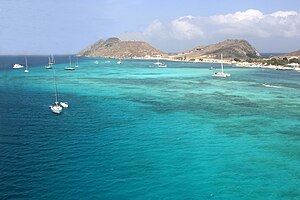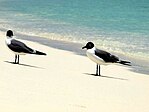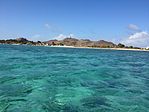Los Roques Archipelago
|
Native name: Dependencia Federal Archipiélago Los Roques Nickname: Los Roques |
||||||||||
|---|---|---|---|---|---|---|---|---|---|---|
|
||||||||||
| Geography | ||||||||||
| Location | Caribbean Sea | |||||||||
| Coordinates | 11°51′27″N 66°45′27″W / 11.85750°N 66.75750°W | |||||||||
| Total islands | 350 | |||||||||
| Major islands | Cayo Grande | |||||||||
| Area | 40.61 km2 (15.68 sq mi) | |||||||||
| Administration | ||||||||||
|
|
||||||||||
| Largest settlement | Gran Roque | |||||||||
| Demographics | ||||||||||
| Population | 3.100 (2014) | |||||||||
| Pop. density | 44.32 /km2 (114.79 /sq mi) | |||||||||
Los Roques archipelago is a federal dependency of Venezuela consisting of approximately 350 islands, cays, and islets in a total area of 40.61 square kilometers. The archipelago is located 128 kilometers (80 mi) directly north of the port of La Guaira.
The islands' pristine coral reef attracts many wealthy visitors, especially from Europe, some of whom come in their own yachts and anchor in the inner, protected shallow waters. Development and tourism are controlled.
Because of the wide variety of seabirds and rich aquatic life, the Venezuelan government declared Los Roques a National Park in 1972.
The archipelago is sparsely populated, having about 1,500 permanent inhabitants; however it receives approximately 70,000 visitors a year, many of them day-visitors who come from Caracas and the mainland.
The major islands of the archipelago have an atoll structure, with two external barriers formed by coral communities, and an inner lagoon and sandy shallows. The park consists of 40.61 km², 1500 km² of coral reefs, 42 coral cays surrounding a shallow central lagoon of 400 km², two barrier reefs (24 km east and 32 km south) and 300 sand banks, islands and cays, ranging in size from Cayo Grande (15.1 km²) to the Gran Roque (1.7 km²). Other important islands are Francisqui, Nordisqui, Madrisqui, and Crasqui.
El Gran Roque is the only populated island in the group. It has an airport suitable for small or STOL aircraft, Los Roques Airport. The airport is controlled from the Maiquetía airport on the mainland.
From El Gran Roque most visitors that arrive, go to the port and travel to the keys in small boats called "peñeros" from 9:00 am to 4:00 pm.
Activities include fishing (bonefish, barracuda, tarpon, jack, and Spanish mackerel), birding, snorkeling, diving, paddling, windsurfing, and kitesurfing, and there is a sea turtle research center located on Dos Mosquises. Accommodations include Pez Raton Lodge, a property primarily used to host fishing guests, Posada Mediterraneo, a five-room inn which accommodates non-fishing guests, and dozens more like El Canto de la Ballena and Posada La Gaviota.
...
Wikipedia









